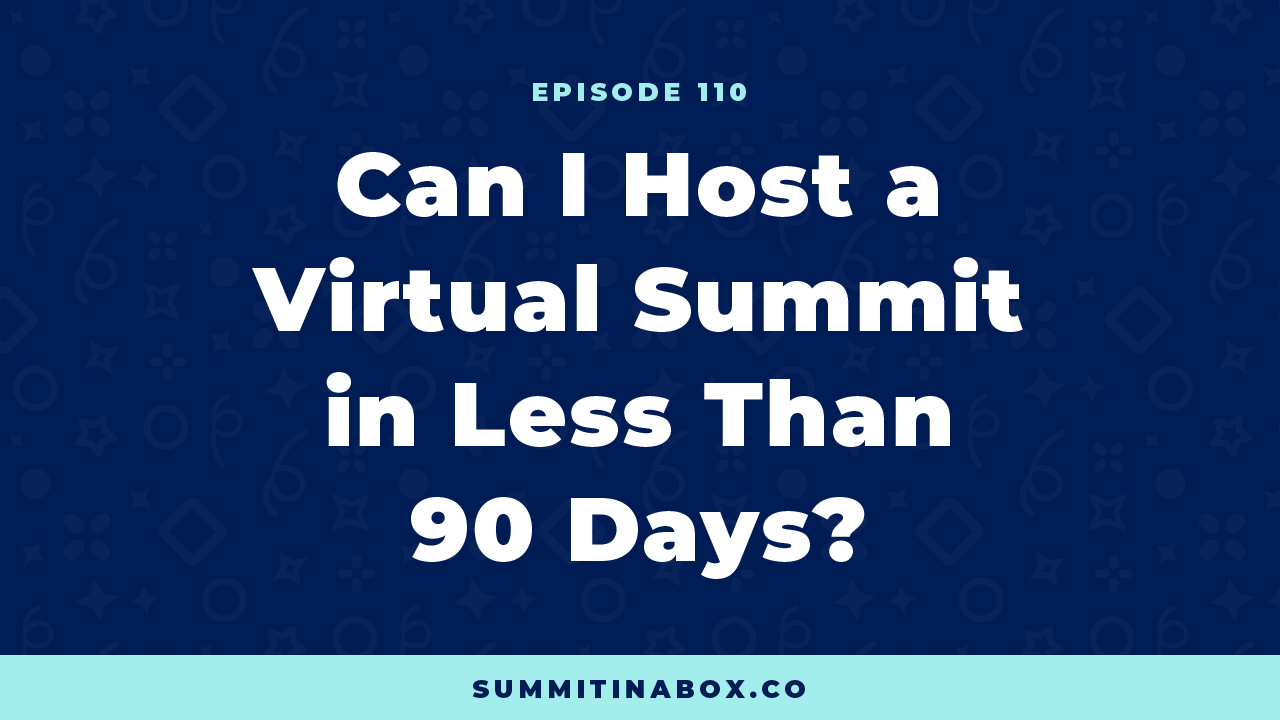Can I Host a Virtual Summit in Less Than 90 Days?


I know what it's like to get a big idea and want to do it, like, yesterday. For a lot of business owners, a virtual summit is one of those big ideas.
With that initial excitement comes disappointment when they hear that I recommend a 90-day timeline for planning and launching a summit.
From there, I tend to hear, "Well...can I host a virtual summit in less than 90 days?"
Let's break that down and cover why I recommend a 90-day timeline, what the biggest pieces of that timeline include, sacrifices you'll need to make by doing it faster, and corners you can cut when 90-days just isn't in the cards.
Can I Host a Virtual Summit in Less Than 90 Days?
It probably doesn't surprise you to hear that I have strong opinions when it comes to my answer to this question, but I'm going to do my best to outline both sides and even tell you where you can sacrifice or cut back a little to save some time.
A 90-day timeline is doable if you:
- Can stay focused on a long-term project.
- Are willing to put in the work for big results down the road.
- See big projects through without getting discouraged.
Keep in mind, you won't spend all your time on the summit during those 90 days. Instead, you’re usually giving other people breathing room.
In the Summit in a Box program, you get a product called the Summit Host Process map. This outlines all of the tasks that you need to complete your summit and also sets due dates for your tasks. Those tasks are set for just 3 days per week! That means you have 2 full days to work on other things in that 90-day timeline. Most of the days won’t be totally full, even when you’re working on summit stuff. But that doesn't mean it's an invitation to try to do it even faster.
Why I Recommend a 90-Day Timeline
Let's go into a few of the primary reasons that I recommend at least a 90-day timeline.
Reason 1: It gives you time to put on a well-rounded event without stressing yourself out.
One of the biggest issues I see with people who rush is that they are stressed. They don’t enjoy the process and they don’t want to do it again. This longer timeline gives you the chance to hit roadblocks and not have to freak out.
For example, if you aren’t as tech-savvy, this also gives you the chance to hit roadblocks and work through them or switch platforms if needed.
Or, if you are tech-savvy, your issue could come with niching down, choosing your topic, and naming your event. With a longer timeline, you can take your time working through these things, rather than feeling rushed to make a decision.
As an added bonus, this longer timeline also allows extra time for details and adding in fun events that you're interested in doing. You’ve given yourself that freedom.
And last, it allows your speakers plenty of time to create their presentations, turn them in, and get their promotion scheduled without anyone feeling rushed.
Reason 2: Plenty of time to set up your website and tech.
I am a firm believer that you don't need any special tech to make a summit happen.
You can use what you're already using in your business, but you still need 1-2 weeks to create your registration page, sales page, and presentation pages.
Reason 3: Time to make connections before pitching.
If you can, leave yourself time to make connections before you start pitching virtual summit speakers. I like to give myself 2 weeks for this so my pitches aren't total surprises to speakers I'm reaching out to.
So an overall speaker pitch timeline might look like:
- 1-2 days to identify who I'm going to pitch.
- 2ish weeks to connect a few times on social media.
- 1-2 weeks to pitch and receive responses.
After that, give your speakers 4+ weeks to create presentations or for interviews to be scheduled, edited, and produced. Don't be one of those hosts who emails wanting a presentation within the next 1-2 weeks. I've actually been pitched for summits before where they wanted it 3 business days later.
Reason 4: You want presentations submitted 3+ weeks before your summit begins.
The next reason to consider a longer timeline is that you'll want presentations submitted at least 3 weeks before your summit begins.
That's because it's not rare for at least 50% of speakers to deliver their presentations late. Allowing those three weeks makes it so no one has to panic.
Instead of emailing speakers saying, “Hey, I really needed this yesterday. I can't even have you in the event if I don't have it from your, by today." You can say, “Hey, the due date was yesterday. I noticed that your presentation isn’t in. Let me know if there's anything I can do to help you and when I can expect to have it from you.”
You can be more friendly and less stressed about the situation because you gave yourself plenty of time.
This extra time will still come in handy if you're doing interviews. With interviews, you'll have speakers reschedule at the last minute or just not show up. Giving yourself extra time means that you won't need to rush to reschedule.
Reason 5: Allow 2-3 for promotion.
And the last big piece to consider in your timeline is promotion. After everything else is set up and ready, you'll want to allow 2-3 weeks to promote your event.
Think about it - if you only gave yourself 5 weeks to put the event together from the start, that means you'd need to be ready to promote a couple of weeks into the process. Now, that is stressful.
Okay, but can I do it faster?
Overall, can you host a summit on a shorter timeline? Yes, but there are sacrifices that come with it. Some of these are sacrifices that may affect the results you see and the experience everyone has.
Top Concerns With a Short Timeline
What concerns me most is your enjoyment of the process and your ability to have any free time.
It will be stressful if you try to pull off a summit on a short timeline. I have some students who have joined my program and put together some in 5 weeks, and now they're my biggest cheerleaders when it comes to my 90-day timeline recommendation. They won't do it again, even with all the templates, trainings, and resources that they have in Summit in a Box.
Keep that in mind, you will be sacrificing basically your sanity to pull off an event on a tight timeline, as well as the experience everyone else has.
Where You Could Cut Corners
If you're set on hosting a summit on a short timeline no matter what, here are a few places you can cut corners to speed up the process without your results taking a big hit:
- Don't worry about a fresh new brand - use what you already have.
- Skip creating a waitlist page and stick with the main registration page.
- Give your speakers less time to create their presentations.
- Send out all your pitches at once, rather than pitching in multiple rounds.
- Skip connecting with speakers who are new to you before you pitch them - go in with a cold pitch.
- Cut back on general bells-and-whistles and bonus features.
- You might decide you need to skip that complex post-summit launch.
Where NOT to Cut Corners
On the other hand, here are a few places you want to dedicate plenty of time and attention to:
- Get the messaging for your summit right. If the messaging is off your conversion rates will take a huge hit.
- Choose the right audience and topic, which will tie into that solid messaging.
- Keep speakers happy and engaged. Just because you're on a tight timeline doesn't mean their experience should suffer.
- Keep attendee engagement a priority.
- Make time to create your own presentation - you still need to be front-and-center during this event.
Speed up the process
And last, to significantly speed up the process:
- Outsource absolutely everything you can!
- Join Summit in a Box®!
So what will you choose?
You can host a summit in less than 90 days, but expect to make sacrifices and cut corners that you wouldn't if you would've given yourself a longer timeline.
If you can, take a deep breath and give yourself that extra time. The added benefits you'll see from giving yourself extra time are worth far more than rushing an event out as quickly as possible.
Resources
- Episode 20: How to Pitch Virtual Summit Speakers And Hear "Yes" More Than "No"
- Episode 21: How to Get Happy and Engaged Virtual Summit Speakers
- Episode 85: What to Outsource in Your Virtual Summit
- Free Masterclass: 3-Part Framework to Triple Your Monthly Revenue with a Virtual Summit (while building your list for free)
- Summit Host Hangout Facebook group
Pin it for later!



5-Minute Virtual Summit Roadmap
The 5-Minute Summit Roadmap leads you through the 7 essential questions that will guide the rest of your summit planning process and help you finally start making meaningful progress toward a profitable event.

